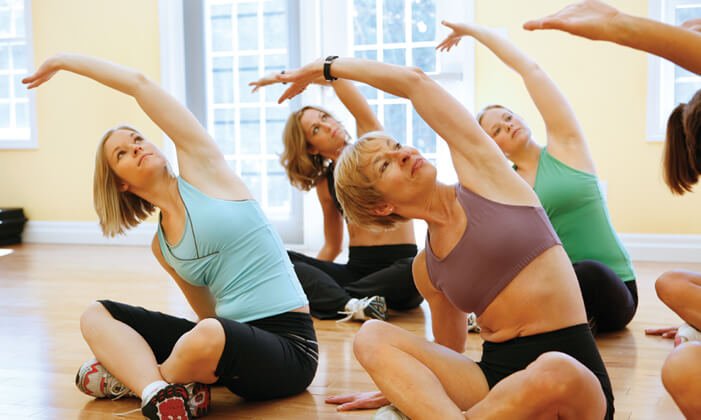Nutrition Q&A: Importance of Exercise

I try to eat right and watch my weight in order to prevent recurrence of breast cancer. What else can I do? It’s great that you are interested in what you can do to manage your weight and prevent cancer recurrence. Nutrition and Exercise go hand in hand, kind of like salt and pepper. Being a breast cancer survivor, how often have you heard that exercise is important to help decrease your chance of recurrence? Hopefully most of you’ve heard it at least once, and if you haven’t, you’re hearing it now. The latest research has shown that regular exercise has a huge beneficial impact on your health, especially being a breast cancer survivor. Not only has it been linked to decreased breast cancer mortality (dying from breast cancer) but it also lowered the risk of overall mortality (dying from any other cause). So how much exercise do you need to reap the benefits? The American Cancer Society (ACS) Guidelines on Nutrition and Physical Activity for Cancer Survivors recommend that breast cancer survivors AVOID BEING INACTIVE. American Cancer Society recommends you start exercising as soon as you possibly can post surgery and/or treatment. Even during treatment I encourage light activity (short walks) to help combat fatigue and clear the mind. Once treatment is complete, and you’ve been given clearance from your physician, it is recommended that you gradually work up to 30 minutes or more of moderated aerobic activity (brisk walking or riding a stationary bike) on five or more days of the week. Results presented from a large study of over 13,000 breast cancer survivors found that women meeting or exceeding the 150 minutes per week guideline had a TWENTY FIVE percent lower risk of dying from breast cancer and 27% lower risk of dying from any other causes. This was compared to breast cancer survivors who were less active. It’s also recommended to add strength-training exercises twice per week for added benefits. This can be done via lifting weights, using exercise bands or other means. But, before attempting strength training, talk with your TurningPoint Physical Therapist. Your therapist can guide you in the right direction based on your current physical abilities.
Patient Perspective: Maria

January 2016 got here quite calmly – until January 26th – the day of my breast cancer diagnosis. Why me? I did things the “right” way. I breast fed my five children, I sort of eat okay and I sort of exercise. My husband and I were settling in to our fifth year of marriage and combining our family of eight children. On top of that, I was eight months in to my favorite job with the Jekyll Island Authority. I am way too busy for this. I spent about a minute contemplating “Why me”? I have a family to take care of – my number one priority! I reluctantly changed my thoughts to “Why not me?” God’s plan is not my plan and this was another moment in my life where I prayed my breath prayer…..”This too shall pass, God how do you want to use me on this journey?” I pray that a lot! With the all-important support of my faithful husband, our four parents, our children, my brother and sister and the rest of our extended family and friends, I underwent a double mastectomy and removal of the right sentinel node on February 12th. With the help of my gynecologist who delivered my five children, I met an amazing cancer surgeon and plastic surgeon who scheduled me quickly and that was a blessing. An integral part of my journey has been the team at TurningPoint – they truly were my turning point. I heard about TurningPoint from both of my wonderful surgeons and their assistants. The day I left my first physical therapy appointment, I cried in the Roswell Road parking lot and thanked God for placing the TurningPoint team in my life. I knew I had found the answer to prayers. I left my first appointment with Lauren and for the first time since January 26th – I felt like I would be normal again – a new normal, but normal. Beyond feeling normal, they helped me to feel so much better physically and emotionally. Lauren and Anita were so patient with the myriad of questions and incredibly reassuring. As women, mothers and full time employees – we take care of others first. The most important thing to do during this time in your life is to take care of yourself first. I didn’t do it – none of us do – but make the time for TurningPoint and encourage others that you meet in our fight to do the same. Let others cook your meals. I didn’t cook for two months. For my family, this was the best part of having Mom down for a while. The prayers will be felt and you will meet people you never knew existed that will enhance your soul. I have been so blessed by the angels that have crossed my path. Would I take back everything that I have been through? Absolutely, because I am not a fighter. However, I have learned that I can fight this because I want to be here for my husband and my children. I want to love on my grandchildren and be with our parents for years to come. I can’t wait to go to my first TurningPoint Pink Affair on March 11, 2017. That night, I will celebrate with other cancer survivors and embrace that I am just over one year cancer free. To all of the newbies out there, be strong, be brave and lean on those us who have “been there, done that”. Know that each journey is individual and frightening, but remember, “THIS TOO, SHALL PASS!” Thank you TurningPoint Team for being part of my team and continue to do your wonderful work inspiring your patients to be survivors.
Patient Perspective: Lorie

Patient Perspective: Lorie For the most part cancer has been good to me. I had some misconceptions about life after treatment; but, now I know better. Because I did well during treatment, I thought after treatment I would jump right back into life where I left off. I didn’t realize I would face a “new normal,” at least for a while, of having to live with discomfort and live a lesser life than the “old normal.” I am very thankful that Jill had a vision for a place like TurningPoint – a place that not only rehabs the physical body but serves to educate and renew the mind and spirit. When I first heard about TurningPoint I thought “Great!”…until I thought about having to drive the distance from my home to the clinic. The emailed intro form stayed in my inbox for two months before I filled it out and returned it. I spent most of that time trying to decide whether I was willing or wanting to drive the distance from Morrow. Since TurningPoint specializes in breast cancer rehabilitation I decided to at least give it a try – to see if they offered anything different than a physical therapist close to home. THEY DO!! I couldn’t believe I needlessly hurt so bad, for so long, and was ready to accept it as my “new normal.” Along this journey I have met many wonderful people and have had access to great resources. It is not enough to have resources available; in order to work they have to be utilized. I am still learning from this journey. I am thankful to be a lifelong learner. TurningPoint, like Dunkin’ Donuts, is worth the trip.
Nutrition Q&A: Cherries, America’s Superfruit

Cherries are one of my favorite fruits. With it being cherry season I have been eating them by the pound. Do they provide any health benefits? Not only are cherries satisfying to eat, they provide a wealth of health benefits earning them the title of “Super Fruit”. Cherries have many important health benefits – from helping ease the pain of arthritis and gout, to reducing risk factors for heart disease, diabetes and certain cancers. Cherries can be one of the recommended 5-9 daily servings of fruits/vegetables recommended for cancer prevention and decreased recurrence. Cherries also contain melatonin, which has been found to help regulate the body’s natural sleep patterns, aid with jet lag, prevent memory loss and delay the aging process. The cherry season runs mid May to mid August with June being the peak of the season, so summer is the perfect time to enjoy them fresh. Even though the season is relatively short, they can be eaten all year round weather dried, frozen or as juice. Cherries have among the highest levels of disease-fighting antioxidants, when compared to other fruits. They also contain other important nutrients such as beta carotene (19 times more than blueberries or strawberries) vitamin C, potassium, magnesium, iron, fiber and folate. Cherries’ red color is provided by the fruit’s powerful antioxidants called anthocyanins. Anthocyanins are responsible for providing the many health benefits stated above. They can reduce inflammation, total cholesterol, and can drastically reduce your risk for heart disease. With more than 80 million Americans living with some form of heart disease, the heart-healthy qualities of eating cherries are more relevant than ever. Anthocyanins can also help ease the pain of inflammatory-related conditions such as arthritis, and gout. Cherries’ post-exercise benefits are good news for the increasing number of active adults who feel the aches and pain of post-exercise muscle soreness. These post-exercise benefits are likely because of the fruit’s natural anti-inflammation properties. As of today there’s no established guideline on how many cherries it takes to reap the benefits, but the experts do suggest that 1-2 servings of cherries daily can help provide some of the health benefits identified in the research. Single serving size examples include: • 1/2 cup dried • 1 cup frozen or fresh • 1 cup juice • 1 ounce (or 2 Tbsp) juice concentrate










